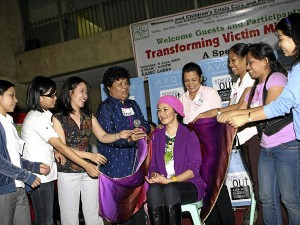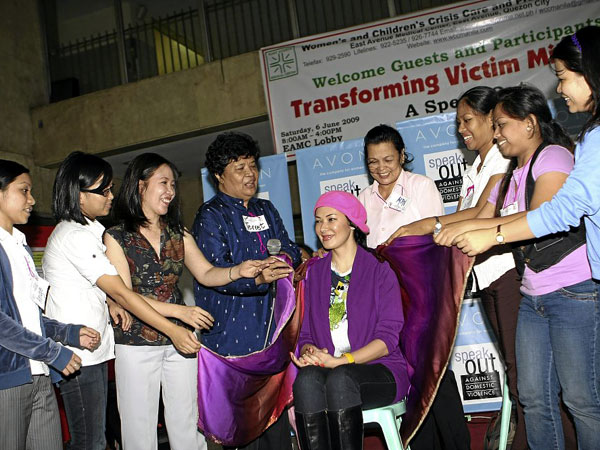
What do you say to a woman, battered and bleeding, who says through her tears, “Mamabutihin ko pa pong mabugbog kaysa makita ang mga anak ko na walang makain, walang matirhan o hindi makapag-aral. [I’d rather get beaten up than see my children go hungry, homeless or unable to go to school].”
Or what do you do when the voice at the end of the line rises to a shriek, and then all you hear is angry cursing, the sound of someone being thrashed about, and you just know the telephone cord is being wound around someone’s neck?
“But that’s not the worst of it. As you’re hearing all this, you realize that you didn’t even get a chance to ask the woman’s name and address. All you know is there’s a woman out there getting battered – and you feel so helpless to get her out,” says Ana Garcia, coordinator for the counseling program of the Women’s Crisis Center (WCC), the non-government arm of the Women’s and Children’s Crisis Care and Protection Unit at the East Avenue Medical Center.
Cases such as these are not rare in a normal work day at this first crisis center in the Philippines for women survivors of rape, battering, incest, sexual harassment, prostitution and sex trafficking. Located within the East Avenue Medical Center, the WCC is able to provide immediate intervention and service primarily to victims of domestic violence.
“Because our center is hospital-based, we already have a protocol for such situations,” explains Garcia. “Whenever doctors suspect that a patient is a VAWC (violence against women and children) case, they refer her to us.”
Still, not all patients suspected of being battered are ready to receive help from the WCC’s Crisis Intervention Counseling Program (CICP). Some may not even be ready to reveal that they are victims of domestic violence.
Says Garcia: “Some don’t even tell the doctor what really happened, like the wives who are afraid of their husbands or an abused girl ashamed to talk about what her father did.”
Instead, she adds, “They’d say they fell or had an accident and hit their head. But doctors know, somehow. And after the women’s medical needs have been attended to, the case is referred to us for the psycho-social dimension. The counseling begins even as we try to get the story out.”
Even more cases of domestic abuse come their way through Lifeline, a telephone hotline service that enables WCC to immediately reach out to battered women.
There are instances when immediate intervention is needed—as in the case of the woman attacked even as she was reporting her case to a counselor. “If she is able to, we ask her to come to the hospital or the crisis center, or to ask help from someone to bring her here. Sometimes they just need to immediately get out the house to flee the violence.”
There are times, however, when the call is exploratory—the woman first wants to know what services the crisis center offers and what options she has. Interestingly, Garcia notes, some callers reveal that they had come upon the WCC’s Lifeline number through media or from a friend, and have kept the number for months or years until they have worked up the courage to make the call.
“If they are not ready for face-to-face counseling, at least there is an opportunity to help her through this Lifeline,” says Garcia.
For the WCC counselor, the immediate and what could be the only but most important intervention, is to assist the caller: first, through affirmation of her self-worth and next, to deal with such emotions as fear, shame, guilt, self-denial and self-blame.
At some point, the client may ask what she should do. And that’s the next challenge for the WCC counselor.
“As a counselor, we cannot decide for her. Precisely, part of the counseling process is to empower her – to give back to her control over herself and mastery of what she is doing, because that is what a woman loses in a situation of violence,” explains Garcia. “It’s actually easier to take over and just decide what she should do – leave her husband, file the case, get him locked up – and it can be really tempting for the counselor. But what we want is for the woman to be empowered, and so we should be ready to journey with her. That can be a long and tedious process and it requires a lot of patience.”
The challenges are not limited to the counselor and client dynamic either. There is the abusive partner whom the WCC counselors have to contend with. When the center still had the funds to operate a shelter for the women who had to flee with their children from their violent spouses, the WCC staff had to face husbands who would barge into the office demanding to know where their wives and children are.
Garcia herself once had to take a leave of absence because she was being stalked by men hired by the abusive husband who wanted to know where the shelter was. Once, a WCC staffer got a call from an irate male who snarled, “Sabihin mo sa Ana na yan, masyado na siyang nakikialam. Gigilitin ko ang leeg niya (Tell that Ana she interferes too much. I’m going to slit her throat)!”
Another time, the WCC staff found themselves trapped in a volatile situation where a husband, who had asked to be allowed to speak to his wife, pulled out an ice pick and threatened to stab her and himself, unless she came back home.
And then there’s what counselors call “vicarious traumatization,” that comes from hearing the stories of violence while seeing actual blood, wounds, welts and bruises. “It can drain you – physically and emotionally – and it can make you feel so powerless to help.”
But these women who help other women know how to pick themselves up.
“We go out – we take a breather. We try to find ways to care for the caregiver,” Garcia smiles. “And then we get ready to answer the next call, whether from the emergency room or through the Lifeline.” •
The WCC has been chosen as the Philippines’ grant recipient of the Avon Global Believe Fund that will launch a pioneering global effort to support women’s domestic violence shelters and agencies. It is also the local NGO partner of Avon’s Speak out against Domestic Violence Global Campaign that has extended more than $23 million to awareness, education, and prevention programs against domestic and gender violence.
The WCC is located at the 3rd Floor, ER-Trauma Annex, East Avenue Medical Center, East Avenue, Diliman, QC. Tel. No. (02) 436-5088. Lifelines: (02) 922-5235; (02) 926-7744. Website: www.wccmanila.com
Five warning signs he could be violent
Is your boyfriend or partner going to be an abusive spouse?
Counselors at the Women’s Crisis Center say they’ve heard it from the victims and survivors of violence so many times before. “I didn’t know he would be an abuser.” Or “I didn’t see the signs. Or maybe I did, but I thought he would change once we were married.”
The truth, however, is that there are signs which, if the women had been more attentive to them while in the relationship, would have warned them of a potentially abusive partner. But the even sadder reality, as experience and statistics at the WCC reveal, is that there is little chance that an abusive (or latently abusive) boyfriend will change after marriage.
Ana Garcia, who has been counseling women victims and survivors of violence for more than a decade, shares some of these indicators:
1.Possessiveness. At the start, a woman may interpret this as protectiveness and even consider it as positive. “She feels good about it because he makes her feel secure,” Garcia says. “But if she starts to feel like he’s guarding her or isolates her from friends and even family, and makes an issue about who she talks to or interacts with – that may lead to problems later on.”
2. Excessive jealousy. Again, this may seem flattering at first, but if it gets to a point when he asks for a full report of how the woman spent her hours, who she’s been with, what she’s doing, etc., listen for the alarm bells. Once his jealousy makes the woman uncomfortable – or even afraid – take heed. If insecurity and lack of trust is at the root of his jealousy, marriage is not going to change that, Garcia warns.
3. The “Dr. Jekyll and Mr. Hyde” syndrome. A contemporary and typical example, Garcia cites, is the boyfriend who maligns his partner by text, using angry, coarse and vulgar words, but who acts like there’s nothing wrong when they’re together. “The woman doesn’t understand where all the anger is coming from—it may not even sound like him. She wants to talk about it when they’re face to face, but he acts like it never happened.” Beware!
4. He tries to change or take over his partner’s personality. It may start out like concern over the way the woman dresses or acts. Then he “helps” her make decisions even for the simplest things—and sulks or fusses if she doesn’t accept the help. If the woman starts making choices she thinks he would approve – just to keep the peace – she may be setting herself up for greater trouble.
5. He gets physical—no matter how lightly. Watch out for even the littlest signs that he is quick with his hands. “Yung patulak-tulak, pabatok-batok (pushing you, nudging you),” even in jest. He may just be holding the fist in check—for now.









































